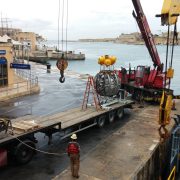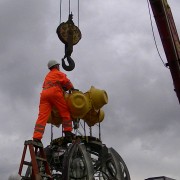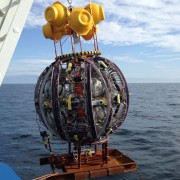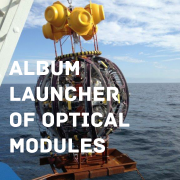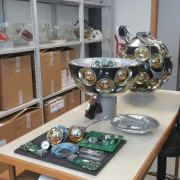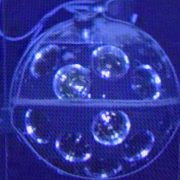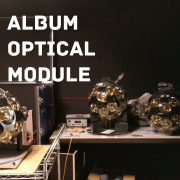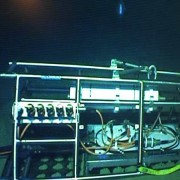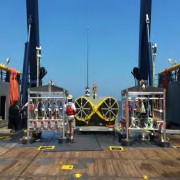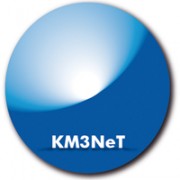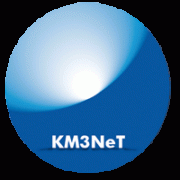Nobel prize for discovery of neutrino oscillations
6 Oct 2015: The KM3NeT Collaboration congratulates Takaaki Kajita and Arthur B. McDonald who were awarded today the Nobel Prize in Physics 2015 “for the discovery of neutrino oscillations, which shows that neutrinos have mass”.
Read the press release of the Royal Swedish Academy of Sciences.
NOvA sees its first neutrino oscillations
10 Aug 2015: Scientists of the NoVA experiments saw their first evidence of oscillating neutrinos.
Read the Press release of Fermilab.
New Lake Baikal telescope. First cluster of GVD neutrino telescope operational.
22 Jul 2015: In the Spring of 2015, the first cluster of the Gigaton Volume Detector (GVD) – the “Dubna Cluster” – has been concluded and is operational since.
Read the article in the CERN courier.
And yet an other boost for KM3NeT. Important upgrade of the deep-sea infrastructure of KM3NeT- It.
20 Jul 2015: In the morning of 20th July 2015, an important upgrade of the deep-sea infrastructure of KM3NeT-It was successfully concluded. During a sea campaign that started three days earlier the old termination frame at the deep sea end of the 100 km long main cable to shore was replaced by a new one and two junction boxes were installed.This major upgrade of the seafloor network at a depth of 3500 m was necessary to allow for the installation of a large number of detection units of the KM3NeT telescope. The first detection units are expected to be connected to the new junction boxes later this year.
More about KM3NeT-It.
Interested to join KM3NeT? The Collaboration invites new members.
23 May 2015: The KM3NeT Collaboration invites interested scientists to join the effort of building and operating the new generation neutrino telescope in the deep seas of the Mediterranean. Currently, the Collaboration is constructing the first phase of the detector. In the KM3NeT-Strategy Report 2015-05-06 you can read about the plans of the Collaboration for the next step, i.e. realising the high-energy ARCA detector at the KM3NeT-It site and the low-energy ORCA detector at the KM3NeT-Fr site.
More about joining KM3NeT.
€15 million boost for European astronomy. Launch of EU funded ASTERICS project.
1 May 2015: Astronomers and astroparticle physicists today are celebrating a €15 million EU funding boost for European telescopes with the launch of the ASTERICS project (Astronomy ESFRI and Research Infrastructure Cluster), which will help solve the Big Data challenges of European astronomy and give members of the public direct interactive access to some of the best of Europe.s astronomy images and data. KM3NeT-Press release 2015-05-06
Again an important step for KM3NeT. First seafloor network node of KM3NeT-Fr installed.
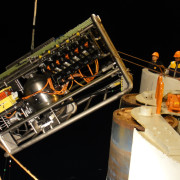 27 Apr 2015: In the early morning of 27th April 2015, the first node of the seafloor network at the KM3NeT-Fr site was successfully installed. This is again an important step in the realisation of the KM3NeT neutrino telescope. During this April campaign, the node was connected to the 40 km long electro-optical cable which connects the network to the shore station. This cable was already deployed during the December campaign of last year.The heart of the node is an egg-shaped titanium vessel with electronics and photonics and sufficient sockets to plug in the cables coming from the many detection units to be anchored on the seabed. The first detection unit is expected to be connected later this year. More about KM3NeT-Fr…
27 Apr 2015: In the early morning of 27th April 2015, the first node of the seafloor network at the KM3NeT-Fr site was successfully installed. This is again an important step in the realisation of the KM3NeT neutrino telescope. During this April campaign, the node was connected to the 40 km long electro-optical cable which connects the network to the shore station. This cable was already deployed during the December campaign of last year.The heart of the node is an egg-shaped titanium vessel with electronics and photonics and sufficient sockets to plug in the cables coming from the many detection units to be anchored on the seabed. The first detection unit is expected to be connected later this year. More about KM3NeT-Fr…
KM3NeT 2.0. The next phase: ARCA and ORCA.
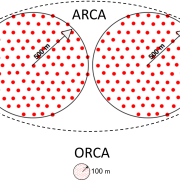 1 Feb 2015: KM3NeT has defined the next step in the realisation of the research infrastructure in the deep seas of the Mediterranean: KM3NeT2.0 to conduct Astroparticle & Oscillations Resreach with Cosmics in the Abyss with ARCA and ORCA.More in the KM3NeT-Strategy Report 2015-05-06.
1 Feb 2015: KM3NeT has defined the next step in the realisation of the research infrastructure in the deep seas of the Mediterranean: KM3NeT2.0 to conduct Astroparticle & Oscillations Resreach with Cosmics in the Abyss with ARCA and ORCA.More in the KM3NeT-Strategy Report 2015-05-06.
The Collaboration is expanding. Morocco joins KM3NeT.
24 Feb 2015: On 24 February, during the KM3NeT Collaboration meeting in Valencia, the Laboratory of Physics Matter and Radiations (LPMR) of the Mohammed 1st University in Oujda formally joined the KM3NeT Collaboration. Focus of the group will be at the search for monolpoles and physics with the low energy ORCA detector in KM3NeT-Fr. With LPMR, the KM3NeT Collaboration now counts 42 institutes in 12 countries. The total number of scientists in the Collaboration is about 240.
Christmas present. First full detection unit ready.
23 Dec 2014: Just before Christmas 2014, the first full KM3NeT detection unit was produced. The 700 m long a string holds 18 optical modules – eyes of the telescope. Shortly after Christmas, the string has been moved to the host institute of KM3NeT-Fr in Marseille, where it will undergo final tests prior to deployment. More…
KM3NeT-Fr. Cable comes to shore.
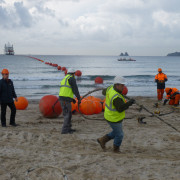 23 Dec 2014: In December 2014, for KM3NeT-Fr near Toulon, the Main Electro-Optical Cable (MEOC) connecting the deep-sea infrastructure with the shore was deployed. This is a major step in the construction of the KM3NeT-Fr installation site. The main cable lands in a power station at the beach of Les Sablettes, La Seyene sur Mer in the South of France. From there a land cable station with the control room of the shore station where the signals from the deep sea are collected, processed and submitted further over the internet to the central data repository in the computer centre in Lyon, France. More on KM3NeT-Fr.
23 Dec 2014: In December 2014, for KM3NeT-Fr near Toulon, the Main Electro-Optical Cable (MEOC) connecting the deep-sea infrastructure with the shore was deployed. This is a major step in the construction of the KM3NeT-Fr installation site. The main cable lands in a power station at the beach of Les Sablettes, La Seyene sur Mer in the South of France. From there a land cable station with the control room of the shore station where the signals from the deep sea are collected, processed and submitted further over the internet to the central data repository in the computer centre in Lyon, France. More on KM3NeT-Fr.
KM3NeT Strategy Document. Phased implementation of the KM3NeT Research Infrastructure.
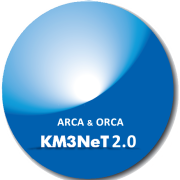 26 November 2014: The KM3NeT Collaboration has published its strategy for a phased construction of the KM3NeT Research Infrastructure at three locations in the deep seas of the Mediterranean at the southern coasts of Europe. The first phase of construction has started with furbishing the KM3NeT-Fr and KM3NeT-It locations with both deep-sea and on-shore infrastructures to host several hundredths of optical sensors of the neutrino telescope and two nodes for connection of instrumentation for earth and sea science research.Final phase of implementation of the research infrastructure include the extension of the neutrino detector to its full size of more than 12,800 sensors for the detection of cosmic neutrinos, the installation of a third node for earth and sea science research at the KM3NeT-Gr location and a neutrino detector dedicated to particle physics research at the KM3NeT-Fr location.As an intermediate phase, KM3NeT 2.0 is planned with an high-energy detector at KM3NeT-It and a low energy detector at KM3NeT-Fr.Read more in the KM3NeT-Strategy Report 2015-05-06
26 November 2014: The KM3NeT Collaboration has published its strategy for a phased construction of the KM3NeT Research Infrastructure at three locations in the deep seas of the Mediterranean at the southern coasts of Europe. The first phase of construction has started with furbishing the KM3NeT-Fr and KM3NeT-It locations with both deep-sea and on-shore infrastructures to host several hundredths of optical sensors of the neutrino telescope and two nodes for connection of instrumentation for earth and sea science research.Final phase of implementation of the research infrastructure include the extension of the neutrino detector to its full size of more than 12,800 sensors for the detection of cosmic neutrinos, the installation of a third node for earth and sea science research at the KM3NeT-Gr location and a neutrino detector dedicated to particle physics research at the KM3NeT-Fr location.As an intermediate phase, KM3NeT 2.0 is planned with an high-energy detector at KM3NeT-It and a low energy detector at KM3NeT-Fr.Read more in the KM3NeT-Strategy Report 2015-05-06
Detectors active at two different sites in the Mediterranean. First KM3NeT detection unit operational in the deep sea.
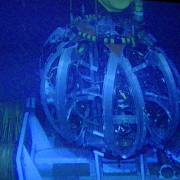 07 May 2014: The first KM3NeT detection was put into operation at the KM3NeT-It installation site, 100 km off the coast of the South East of Sicily, at a depth of 3500 m. Since more than a year, the first KM3NeT optical module is already operational inside the ANTARES telescope, situated close to the KM3NeT-Fr installation site, 40 km south of Toulon at a depth of 2400 m. With the successful completion of these two important technological steps at two different installation sites, the realisation of the first phase of the distributed KM3NeT neutrino telescope is well on its way. KM3NeT-Press release 2014-05-11
07 May 2014: The first KM3NeT detection was put into operation at the KM3NeT-It installation site, 100 km off the coast of the South East of Sicily, at a depth of 3500 m. Since more than a year, the first KM3NeT optical module is already operational inside the ANTARES telescope, situated close to the KM3NeT-Fr installation site, 40 km south of Toulon at a depth of 2400 m. With the successful completion of these two important technological steps at two different installation sites, the realisation of the first phase of the distributed KM3NeT neutrino telescope is well on its way. KM3NeT-Press release 2014-05-11
Evidence for high-energy extra-terrestrial neutrinos. IceCube pushes neutrinos to the forefront of astronomy.
22 Nov 2013: The IceCube collaboration reported in Science Magazine the observation of 28 very high-energy particle events that constitute the first solid evidence for astrophysical neutrinos from cosmic accelerators. Read more about this exciting news at the Icecube website.
GNN. The Global Neutrino Network formed.
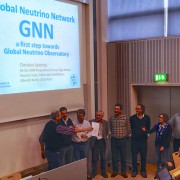 15 Oct 2013: The spokespersons of the ANTARES, Baikal, IceCube and KM3NeT Collaborations established the Global Neutrino Network (GNN) by signing a memorandum of understanding “for a closer collaboration and a more coherent strategy among the four neutrino telescope communities, resulting in significant synergistic effects and benefits for each individual project to pursue its science goals”. The GNN is the first step toward a truely Global Neutrino Observatory.
15 Oct 2013: The spokespersons of the ANTARES, Baikal, IceCube and KM3NeT Collaborations established the Global Neutrino Network (GNN) by signing a memorandum of understanding “for a closer collaboration and a more coherent strategy among the four neutrino telescope communities, resulting in significant synergistic effects and benefits for each individual project to pursue its science goals”. The GNN is the first step toward a truely Global Neutrino Observatory.
2013 Nobel Prize Physics. The Higgs boson.
08 Oct 2013: The 2013 Nobel Prize Physics is awarded to Francois Englert and Peter W. Higgs for “their theoretical discovery of a mechanism that contributes to our understanding of the origin of mass of subatomic particles and which recently was confirmed through the discovery of the predicted fundamental particle, by the ATLAS and CMS experiments at CERN’s Large Hadron Collider.”
VLVnT13 workshop. Very Large Volume neutrino Telescopes.
08 Aug 2013: On 5-7 August 2013, at the Oscar Klein Centre for Cosmoparticle Physics of Stockholm University, the global community operating and building Very Large Volume neutrino Telescopes (VLVnT) came together at the VLVnT13 workshop to discuss the scientific results of the operational telescopes, the status of construction of new telescopes and the plans for extension of the telescopes. It was the 6th edition of the VLVnT workshop series which started 10 years ago, in October 2003.
IcuCube records first high energy neutrinos. “Bert and Ernie”,
19 April 2013: On 19th April 2013, the IceCube collaboration reported the first observation of PeV-energy neutrinos. Two neutrino-induced events which are christianed ‘Bert’ and ‘Ernie’ have deposited in the IceCube detector at the Southpole an estimated energy of 1.04 and 1.14 PeV respectively. They represent the highest neutrino energies observed so far. Details of the measurement can be found in a paper available at the arXiv.
KM3NeT DOM “sees” muons. First KM3NeT optical module operational in the deep sea
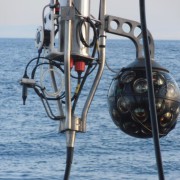 16 Apr 2013: On 16th April 2013, the first KM3NeT DOM (Digital Optical Module) was put into operation in the deep sea. For this, the module has been installed on the instrumentation line of the ANTARES neutrino telescope. KM3NeT-Press release 2013-06-03
16 Apr 2013: On 16th April 2013, the first KM3NeT DOM (Digital Optical Module) was put into operation in the deep sea. For this, the module has been installed on the instrumentation line of the ANTARES neutrino telescope. KM3NeT-Press release 2013-06-03
KM3NeT String Deployment method. Qualification tests near Motril, Spain.
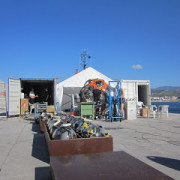 15 Apr 2013: During the first two weeks of April, an extensive qualification programme has been executed to qualify the novel string deployment method of KM3NeT. More…
15 Apr 2013: During the first two weeks of April, an extensive qualification programme has been executed to qualify the novel string deployment method of KM3NeT. More…
Short video demonstrating this concept can be found at  .
.
KM3NeT Collaboration formed. First KM3NeT management team elected.
29 Jan 2013: On 29 January 2013, 40 institutes formed a collaboration for the implementation of the first phase of the KM3NeT Research Infrastructure. A governance and management structure was installed. The executive management team was elected.
November 2012
On December 5-6, 2012, the INFN group of KM3NeT will organise an ORCA workshop at Catania. ORCA stands for Oscillations Research using Cosmics in the Abyss. It is a study for the feasibility of a neutrino mass hierarchy measurement with the technology of KM3NeT.
October 2012
An interim management team has been installed to prepare a Memorandum of Understanding and the installment of a Collaboration structure for the implementation of the first phase of the KM3NeT Research Infrastructure (KM3NeT-phase1).
Juli 2012
KM3NeT in the CERN Courier.
June 2012
After the conclusion of the Preparatory Phase the formation of a Collaboration for the first phase of KM3NeT is being prepared by senior scientists of KM3NeT.
March 2012
After a positive midterm review, the Dutch governement prolonges the position of KM3NeT on the Netherlands roadmap for Large Scale Research Infrastructures.
February 2012
On 20-23 February 2012, the KM3NeT consortium will conclude the Preparatory Phase with a General Assembly meeting in Catania.
November 2011
The Italian ministry of research has approved 20.8 MEuro for the construction of 30 KM3NeT detection units.
March 2011
The KM3NeT consortium has made public the final version of the Technical Design Report (TDR) for the KM3NeT research facility in the Mediterranean Sea.
The KM3NeT has published the description of the pre-production model of the detection unit of KM3NeT.
July 2010
The KM3NeT consortium has published a preliminary version of the Technical Design Report (TDR) for the KM3NeT research facility in the Mediterranean Sea. A printed version of the report is in preparation.
March 2010
New pages has been added to the website with images, clips and movies of technical designs and prototypes that emerged from the Design Study: images and clips and movies.
February 2010
On February 13, 2010 a succesfull deployment of an other mechanical model of a KM3NeT detection unit took place close to the candidate site near Capo Passero, Italy. Also this compact deployment method followed by unfurling was succesfully tested (see Quicktime movie)
December 2009
On December 16, 2009 a succesfull deployment of a mechanical model of a KM3NeT detection unit took place close to one of the candidate sites near Pylos, Greece. It was the first time that a compact deployment of a self buoyant system followed by unfurling of the detection unit was tested. (see short clip of the unfurling wmv-format or avi-format).
November 2009
The Design Study terminated 31th October 2009. The resulting Technical Design Report (TDR) will be published early 2010. The consortium proceeds with the Preparatory Phase to prepare the construction of the KM3NeT telescope.
July 2009
During a dedicated KM3NeT workshop in Marseille, the contents of the Technical Design Report (TDR) for KM3NeT has been discussed. An editorial board has been appointed for the TDR which is expected to be published at the end of this year.
March 2009
At the TIPP09 conference on Technology and Instrumentation in Particle Physics, the poster presentation “Position Calibration for the KM3NeT Detector” of Holger Motz (ECAP, Erlangen, Germany) was selected for the proceedings to be published in NIMA. The conference convenors selected out of 116 poster presentations, the best 20, among which the presentation of Holger. poster (pdf), TIPP09
November 2008
The Dutch minister for Education and Research has granted the KM3NeT groups of Nikhef, KVI and NIOZ 8.8 MEuro investment money.
August 2008
KM3NeT is open for new partner institutes and invites corresponding expressions of interest. Look here for more information.
May 2008
At 30 May the construction of the ANTARES telescope has been completed. Click here for more information.
April 2008
At the VLVnT08 Workshop, the Conceptual Design Report for KM3NeT has been made public. Click here for a pdf version.
March 2008
On 22-24 April, 2008, CPPM, partner in KM3NeT will organise the International Workshop on a Very Large Volume Neutrino Telescope for the Mediterranean Sea – VLVnT08.
Since March 1st, 2008, the KM3NeT consortium has started the Preparatory Phase of the project parallel and in close connection to the Design Study. The Preparatory Phase project, which is funded in the FP7 Frame Work Program of the European Committee, will last for three years. The kick-off meeting was organised 10-14 March 2008 at the LNS institute in Catania followed by a General Assembly meeting of the KM3NeT Design Study project.
Januari 2008
The kick-off meeting of the KM3NeT Preparatory Phase project will take place in Catania, 10-11 March, 2008. The meeting will be followed by a General Assembly meeting of the KM3NeT Design Study project.
December 2007
At the International Conference on Sensor Technologies and Applications in Valencia, the presentation “KM3NeT, a Deep Sea Challenge for Neutrino Astronomy” by Ciro Bigongiari, IFIC, has been received one of the Best Paper awards of the conference. (view the paper)
December 18th, the Mid-term review of KM3NeT will take place in a meeting at CPPM, Marseille.
Our website has been restyled. We are now working on an update of the content.
November 2007
During a workshop in Amsterdam, 12-16 November, a first version of the Conceptual Design Report (CDR) for the KM3NeT facility has been produced. Look at the pictures. During the mid-term review of the design study at December 18th in Marseille, the CDR will be presented to the EU scientific officer. After official approval by the KM3NeT General Assembly the CDR will become public in April 2008, during the VLVnT08 workshop in Toulon.
Jos Engelen, Chief Scientific Officer of CERN in the ASPERA newsletter: “It is natural to get excited about astroparticle physics”. Read more
August 2007
The KM3NeT consortium has been invited to start negotiations for a contract with the EC in the European 7th frame work program (FP7) in support of its preparatory phase.
July 2007
At the EPS conference on High Energy Physics Lee Thompson won one of the Nuclear Physics B prizes for the best posters. View the poster.
Five contributions of KM3NeT to the ICRC2007 conference. Read more.
June 2007
KM3NeT in the Newsletter of ASPERA. Read more.
KM3NeT at the RICAP07 conference in Rome. View the slides
May 2007
May 2nd, 2007 the KM3NeT consortium has submitted a proposal for its preparatory phase in the European 7th frame work program (FP7).

